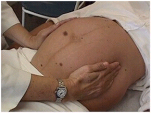|
Labor Labor consists of regular, frequent, uterine
contractions which lead to progressive dilatation of the cervix.
The diagnosis of labor may not be obvious for several reasons:
- Braxton-Hicks contractions are uterine contractions occurring
prior to the onset of labor. They are normal and can be demonstrated
with fetal monitoring techniques early in the middle trimester of
pregnancy. These innocent contractions can be painful, regular, and
frequent, although they usually are not.
- While the uterine contractions of labor are usually painful,
they are sometimes only mildly painful, particularly in the early
stages of labor. Occasionally, they are painless.
- Cervical dilatation alone does not confirm labor, since many
women will demonstrate some dilatation (1-3 cm) for weeks or months
prior to the onset of true labor.
Thus, in other than obvious circumstances, labor will usually be
determined by observing the patient over time and demonstrating
progressive cervical changes, in the presence of regular, frequent,
painful uterine contractions.
The cause of labor is not known but may include both maternal and
fetal factors.
|
 Latent Phase Labor
The first stage of labor is that portion leading up to complete
dilatation. The first stage can be divided functionally into two
phases: the latent phase and the active phase.
Latent phase labor (also known as prodromal labor) precedes the
active phase of labor. Women in latent phase labor:
- Are less than 4 cm dilated.
- Have regular, frequent contractions that may or may not be
painful.
- May find their contractions wax and wane
- Dilate only very slowly
- Can usually talk or laugh during during their contractions
- May find this phase of labor lasting days or longer.
Active Phase Labor
Active phase labor is a time of rapid change in cervical
dilatation, effacement, and station.
Active phase labor lasts until the cervix is completely dilated.
Women in active phase labor:
- Are at least 4 cm dilated.
- Have regular, frequent contractions that are usually moderately
painful.
- Demonstrate progressive cervical dilatation of at least 1.2-1.5
cm per hour.
- Usually are not comfortable with talking or laughing during
their contractions.
Progress of Labor
For a woman experiencing her first baby, labor usually lasts about
12-14 hours. If she has delivered a baby in the past, labor is
generally quicker, lasting about 6-8 hours. These averages are only
approximate, and there is considerable variation from one woman to the
next, and from one labor to the next.During labor, the cervix dilates (opens) and effaces
(thins). This process has been likened to the process of pulling a
turtleneck sweater over your head. The collar opens (dilates) to allow
your head to pass through, and also thins (effaces) as your head
passes through.
The process of dilatation and effacement occurs for
both mechanical reasons and biochemical reasons.
The force of the contracting uterus naturally seeks to
dilate and thin the cervix. However, for the cervix to be able to
respond to these forces requires it to be "ready." The process of
readying the cervix on a cellular level usually takes place over days
to weeks preceding the onset of labor.
Descent means that the fetal head descends through the
birth canal. The "station" of the fetal head describes how far it has
descended through the birth canal.
This station is determined relative to the maternal
ischial spines, bony prominences on each side of the maternal pelvic
sidewalls.
"0 Station" ("Zero Station") means that the top of the
fetal head has descended through the birth canal just to the level of
the maternal ischial spines.
This usually means that the fetal head is "fully"
engaged (or "completely engaged"), because the widest portion of the
fetal head has entered the opening of the birth canal (the pelvic
inlet).
Continue
to the PowerPoint Lecture...
From:
Operational Obstetrics & Gynecology
2nd Edition
NAVMEDPUB 6300-2C
Bureau of Medicine and Surgery
Department of the Navy
|


